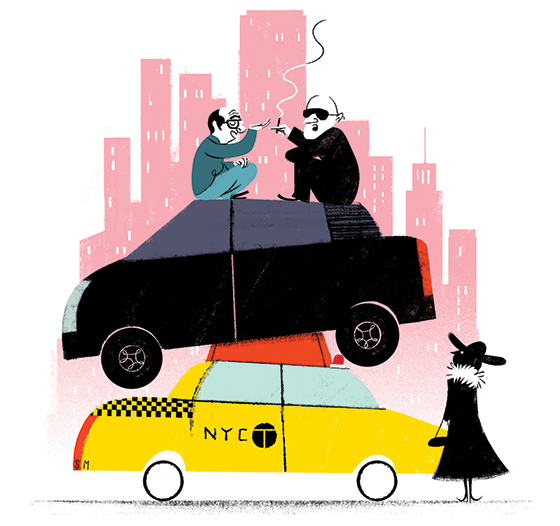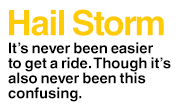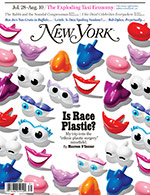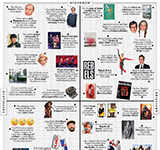 |
Illustration by Simone Massoni
|
Hass*: We met two years ago when we were both driving yellow cabs. Then I switched over to Uber. I’m trying to recruit Amr, but he is in love with yellow cabs for some reason.
Amr: He tries to recruit me every day. But I always hear stories about the rating system—it’s not fair, it’s arbitrary. Someone who gets in your car doesn’t like the way you look and, boom, one star. Another person wants you to pick them up on the right side of the street, but you can’t because that’s a bus lane, which he doesn’t understand. Boom, one star.
Hass But you also get to rate the customer.
Amr: But what happens to the customer if they get a bad rating?
Hass: Nothing.
Amr: Exactly.
- The Great Taxi Upheaval Is Here
- 6 Ways to Summon Drivers
- Talking With Taxi Drivers
- The New Ridescape: Comparing Taxi Options
- A Look at Taxi Provider Disputes
- The Boro-Taxi Revolution
- Is Uber Worth Its Obnoxious Customers?
- John Zimmer on Lyft's New York Debut
- Talking With Women Drivers
- 24 Hours in One Taxi
Hass: It’s up to the driver to accept a bad client. My cutoff is three. If I see a passenger with that low a rating, I don’t risk it. A passenger with a three is an angry customer.
Amr: People who ride with Uber think they are big shots. In a yellow cab, if they don’t like you, what are they going to do? I still get paid and get to keep driving. But with the rating system, if you go below four stars or something, you can be out of a job.
Hass: Four point four is the cutoff.
Amr: Exactly. And let me say this in a straight and honest way: Some people are racist. Okay? Hass, what about what happened to you? Are you still mad about that?
Hass: When I first started with UberX, I was getting a lot of negative ratings. I asked the other drivers, “Guys, what am I doing wrong?” And they said, “Listen, you got to put some candy and water in the back.” I did, but my rating didn’t move. So then I cut my name in half, to Americanize it, and after two months my rating had jumped up. Now I also make sure I have several phone chargers, auxiliary cords if people want to play their music, and magazines in the back of my car. On special occasions, like Easter, I’ll go to CVS and buy chocolate bunnies to hand out. It is in my interest to do this. I make two times what Amr makes.
Amr: When I started in 1999, the medallion cost me $480 to rent per week. Now I pay about $1,000. My expenses for today, for example, were $115 to lease the medallion, an $11 fee on the credit-card machine, an $8.50 MTA tax fee, another $5 tax, $42 for E-Z Pass, plus gas, adding up to roughly $200. And on the weekends, add an extra $20 to lease the medallion.
Hass: The minimum base fare on an Uber SUV is $25. Uber takes 30 percent of that, then there’s insurance, so it comes out to me taking home about 60 percent. Amr is paying $200 for his 12-hour shift, and I’m paying $70. And I’m not fixed in a shift like he is. I can drive in just the rush hours. I control my own hours.
Amr: One of the bad things of a yellow cab is you don’t have a social life. You work the 12-hour shift six days straight. That’s why I work four months and then go home to Egypt for four months. I’d be dead of a heart attack if I did this year round.
Hass: When I was a yellow-cab driver, I was a bully. I’d cut other drivers off. Now I am more respectful, calm. I know where my fares are. Robberies don’t happen with Uber, because we track all the customers.
Amr: With yellow cabs, people run out of the car and don’t pay. Or you take them all the way from the airport and they give you a dollar tip.
Hass: You can’t do this with Uber. We have their credit cards.
Amr: If TLC were to release an app, and I’d get paid Uber prices, I would for sure join.
Hass: But even though Uber is a threat to other black cars, it’s not to yellow cabs.
Amr: You’re kidding me, right? I make at least 25 percent less weekly than I did before Uber and green cabs. If a passenger is in midtown and it’s raining, it used to be that the passenger would wait for you—I could drop off one passenger and come back and the same passenger would still be waiting. Now he’ll order an Uber. Rush hour used to be three and a half hours, now it’s an hour and a half.
Hass: But you guys were refusing rides a lot of the time, too.
Amr: That’s not true.
Hass: It’s 100 percent true. Uber has come into the picture to satisfy this.
Amr: Satisfy it for how much? How much do you charge, my friend? With your surge pricing, the same guy that I take for $10 you take for $100.
Hass: Customers want to refuse the surge price, they can refuse it. When prices go up, they know before they order the car.
Amr: That’s Uber. When it is too busy, they raise the price. The yellow cab is the same rate in rain, sun, and traffic.
 Subscribe
Subscribe


 David Edelstein on Essential Documentary The Kill Team
David Edelstein on Essential Documentary The Kill Team
 The Approval Matrix
The Approval Matrix Hoffman at His Peak in Most Wanted Man
Hoffman at His Peak in Most Wanted Man The Year of Posthumous Performances
The Year of Posthumous Performances

 Leitch: Is Data Spoiling Fandom?
Leitch: Is Data Spoiling Fandom?
